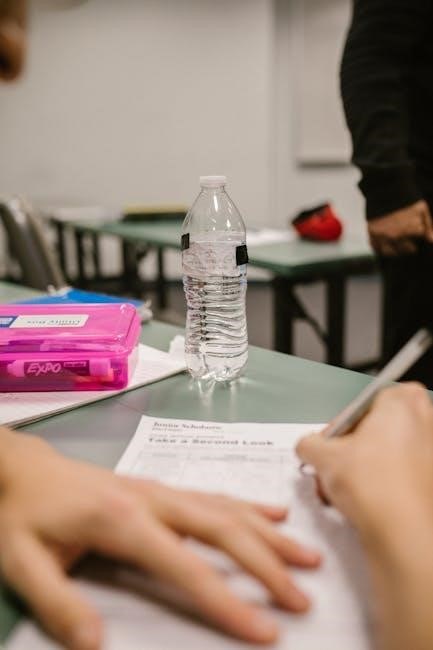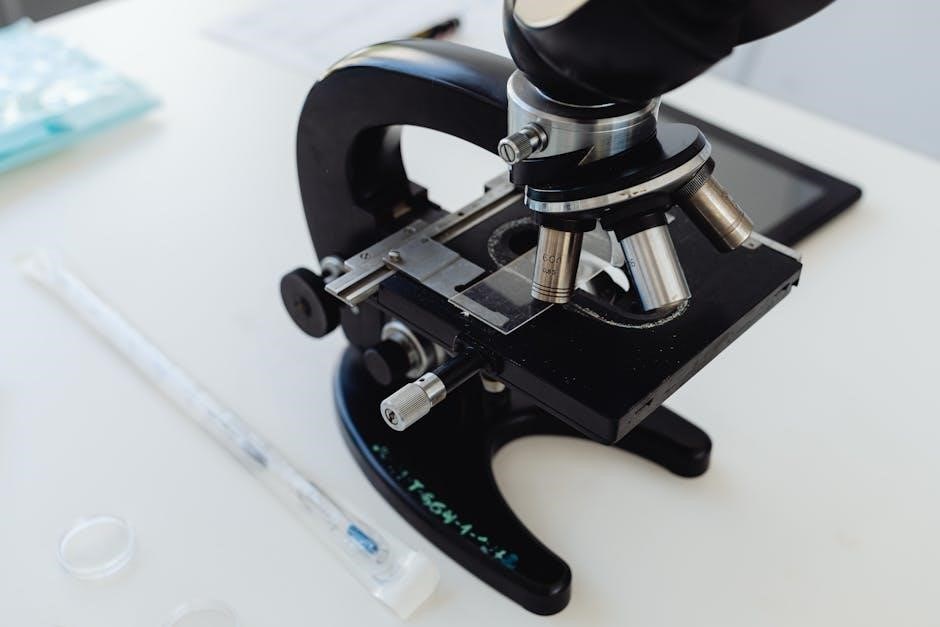Similar triangles are a fundamental concept in geometry‚ where two triangles have the same shape but different sizes. They possess equal corresponding angles and proportional side lengths‚ enabling various applications in problem-solving and real-world scenarios.
Definition and Basics of Similar Triangles
Similar triangles are triangles that have the same shape but not necessarily the same size. This means their corresponding angles are equal‚ and their corresponding sides are proportional. The basic idea of similarity is rooted in the concept that two triangles can be scaled versions of each other. For triangles to be similar‚ their angles must be congruent‚ and their sides must be in proportion. This fundamental principle is crucial in geometry and is applied in various problem-solving scenarios. Understanding the basics of similar triangles lays the groundwork for exploring more complex topics like similarity criteria and real-world applications. By mastering this concept‚ students can efficiently solve problems involving proportional relationships and apply them to practical situations.

Criteria for Similar Triangles
The criteria for determining similar triangles include AA (Angle-Angle)‚ SAS (Side-Angle-Side)‚ and SSS (Side-Side-Side) similarity‚ each providing a unique method to establish triangle similarity.

AA (Angle-Angle) Similarity
The AA (Angle-Angle) similarity criterion states that if two angles of one triangle are congruent to two angles of another triangle‚ the triangles are similar. This is because the sum of angles in a triangle is always 180 degrees‚ so if two angles match‚ the third must also be equal. This criterion is particularly useful when working with triangles where angle measures are known or can be easily determined. For example‚ in triangles ABC and XYZ‚ if angle A is equal to angle X and angle B is equal to angle Y‚ then triangle ABC is similar to triangle XYZ by AA similarity. This method is straightforward and relies solely on the equality of angles‚ making it a fundamental tool in proving triangle similarity in various geometric problems.
SAS (Side-Angle-Side) Similarity
The SAS (Side-Angle-Side) similarity criterion states that if two sides of one triangle are proportional to two sides of another triangle and the included angle between these sides is equal‚ then the triangles are similar. This method is reliable because it ensures that the triangles have the same shape‚ even if their sizes differ. For instance‚ in triangles ABC and XYZ‚ if side AB is proportional to side XY‚ side BC is proportional to side YZ‚ and the included angle B is equal to angle Y‚ then triangle ABC is similar to triangle XYZ by SAS similarity. This criterion is especially useful when side lengths and an included angle are known‚ making it a practical tool for proving similarity in geometric problems.
SSS (Side-Side-Side) Similarity
The SSS (Side-Side-Side) similarity criterion states that if the lengths of all three sides of one triangle are proportional to the lengths of all three sides of another triangle‚ then the triangles are similar. This means that the corresponding angles of the triangles are also equal‚ ensuring that the triangles have the same shape but possibly different sizes. For example‚ if triangle ABC has sides measuring 4‚ 5‚ and 6 units‚ and triangle DEF has sides measuring 8‚ 10‚ and 12 units‚ the ratios of the corresponding sides are equal (4:8‚ 5:10‚ 6:12 = 1:2). Therefore‚ triangle ABC is similar to triangle DEF by the SSS similarity criterion. This method is particularly useful when only side lengths are known‚ making it a practical tool for proving triangle similarity in various geometric problems and real-world applications.

Proving Triangles are Similar
Proving triangles are similar involves demonstrating that their corresponding angles and sides meet specific criteria‚ such as AA‚ SAS‚ or SSS similarity‚ ensuring their shapes are identical but sizes may differ.
Using AA‚ SAS‚ and SSS Criteria
Proving triangles similar using AA‚ SAS‚ or SSS criteria involves demonstrating proportional relationships. AA similarity requires two corresponding angles to be congruent‚ ensuring the third angles are equal due to the triangle angle sum. SAS similarity mandates two sides and the included angle to be proportional‚ establishing similarity. SSS similarity requires all three sides to be proportional‚ confirming identical shapes. These methods are foundational in geometry‚ enabling the comparison of triangles for various applications‚ from solving real-world problems to scaling designs.

Applications of Similar Triangles
Similar triangles are invaluable in architecture‚ engineering‚ and art for scaling designs. They aid in creating proportional models‚ blueprints‚ and maps‚ ensuring accuracy and consistency across different sizes and scales.
Real-World Examples and Problem Solving
Similar triangles are widely used in real-world applications‚ such as architecture and engineering‚ to create proportional models and blueprints. For instance‚ scaling building designs ensures consistency across different sizes. In art‚ they help create perspective and proportional drawings. Additionally‚ similar triangles are essential in problem-solving scenarios‚ like determining the height of a tree or the distance of a landmark using shadow lengths. By setting up proportions based on corresponding sides‚ students can solve practical problems efficiently. These examples highlight how the concept of similarity bridges geometry with everyday challenges‚ making it a powerful tool for critical thinking and innovation. Understanding this enables learners to apply mathematical principles to real-life situations‚ fostering both academic and practical skills.

Practice Problems and Solutions
Engage with practical exercises to identify similar triangles and calculate proportional sides. Solutions provide step-by-step guidance‚ reinforcing understanding and application of similarity concepts in problem-solving scenarios.

Identifying Similar Triangles
Identifying similar triangles involves checking if their corresponding angles are equal and their sides are proportional. Using the AA‚ SAS‚ and SSS criteria helps determine similarity. Practice problems guide learners through matching triangles based on these principles‚ ensuring accurate identification. Solutions clarify common mistakes‚ enhancing understanding and problem-solving skills.

Calculating Proportional Sides and Angles
Calculating proportional sides and angles in similar triangles involves using the ratios derived from their corresponding sides. By identifying matching angles and sides‚ students can set up proportions to find unknown measurements. Real-world applications‚ such as scaling models or solving practical problems‚ demonstrate the importance of proportional relationships. Practice problems guide learners through these calculations‚ ensuring accuracy and understanding. Solutions often highlight common errors‚ such as incorrectly setting up ratios or misidentifying corresponding parts. Mastering these skills is essential for advanced geometry and problem-solving. Regular practice and review of proportional relationships help solidify this concept for learners.

Common Mistakes and Tips
When working with similar triangles‚ common mistakes include incorrectly identifying corresponding angles and sides‚ leading to inaccurate proportions. Students often confuse similarity with congruence‚ forgetting that similar triangles can differ in size. Another error is misapplying similarity criteria‚ such as assuming SSA (Side-Side-Angle) similarity‚ which isn’t a valid theorem. To avoid these mistakes‚ focus on clearly labeling corresponding parts and double-checking proportions. Additionally‚ ensure a thorough understanding of AA‚ SAS‚ and SSS criteria before attempting proofs. Regular practice with a variety of problems helps build confidence and reduces errors. Utilizing visual aids like diagrams can also enhance comprehension and help students avoid common pitfalls. By being meticulous and methodical‚ learners can master similar triangles and excel in geometry;

Test-Taking Strategies
Mastering test-taking strategies is crucial for success in similar triangles. Start by thoroughly understanding the concepts of AA‚ SAS‚ and SSS similarity criteria. Practice identifying corresponding angles and sides to avoid confusion. Skim the entire test first to manage time effectively‚ tackling easier questions initially to build confidence. For proofs‚ carefully label diagrams and show all steps clearly. When solving proportions‚ double-check calculations to prevent arithmetic errors. Use process of elimination for multiple-choice questions‚ eliminating obviously incorrect answers first. Allocate time wisely‚ spending more on complex proofs and less on straightforward identification questions. Review answers briefly before submitting‚ ensuring all steps are logical and complete. By staying calm‚ reading questions carefully‚ and applying learned strategies‚ students can maximize their scores and demonstrate a strong grasp of similar triangles.
